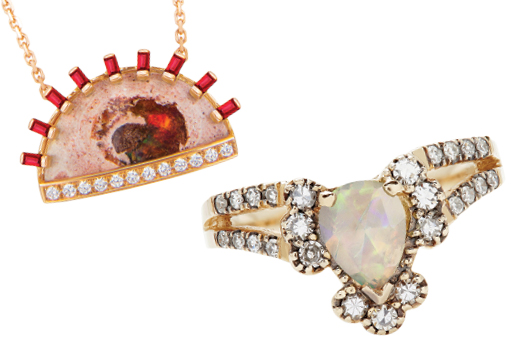
Flick through social media, and it’s clear how much attention opals are getting right now. Once considered an unlucky stone — no doubt due in part to the gems’ fragility, which can leave cutters’ hands quaking at the wheel — the opal has enjoyed a stark turnaround in popularity.
Gem dealer Jeffrey Bilgore, who has bought gemstones on behalf of companies such as Oscar Heyman, Tiffany & Co. and Van Cleef & Arpels, says interest in opals has risen in recent years and that US demand is strong. American jeweler Le Vian is also betting on opals, which it plans to sell under the banner of Phenomena Gems — its trademarked category of stones with distinctive gemological features. Its branded Neopolitan Opal joins the likes of Peacock Aquaprase in this category, which Le Vian highlighted in its 2020 trend forecast.
Across the pond, opals remained in vogue during last month’s Paris Haute Couture Week — a time when major luxury jewelry houses present new top-of-the-line pieces to collectors from around the globe. Chaumet used Australian black opal beneath clusters of diamond stars to mimic the night sky in its Les Ciels de Chaumet collection, while David Morris’s Enchanted Isle line used it to represent the sea off the coast of Mykonos.
“Australian black opal is the most sought-after by high luxury and gemstone enthusiasts,” says jewelry designer Victoria Tse, who sells opal jewelry to both collectors and stores. Yet she believes the demand for opals is being driven from within the trade rather than by consumers, meaning stores need to work hard to ensure the hype doesn’t fall flat on the sales floor. “The interest and exposure of opals has increased mostly from the gemstone dealers and designers,” she says. “In order to increase demand among the consumer market, brands and retailers need to educate their customers on all the beautiful and colorful properties of this stone.”
Source of value
Australia remains the global benchmark for opals, but alternative sources have opened up access to the gem, fueling its popularity.
“Since the early 2000s, Ethiopia has produced large quantities of lively, gem-quality opal material,” says Stuart Robertson, research director at Gemworld International. “This had the effect of further expanding demand for opal, since the Ethiopian material was initially very inexpensive even for large freeform and cabochons.”
In fact, he continues, “the market does not currently assign the same value structure to Ethiopian opal as is seen for the Australian material. This is a result of both the large quantity of Ethiopian opal brought to market in a short time, and concerns that arose about some Ethiopian opal being absorbent. Absorbency caused concerns that the material could change appearance and/or weight in a short period of time.”
Comparing the two sources, Robertson says most Ethiopian opals tend to fetch between $30 and $100 per carat, while Australian white opals will cost between $200 and $500 a carat. The price of black Australian opals is even higher, since they’re catching the eyes of serious collectors and becoming increasingly hard to source. Last year, a collection of 12 uncut Australian Lightning Ridge black opals, ranging in size from 21 to 6,085 carats, had an asking price of $10.8 million; gemologist Gracie Hays — owner of The Gem Garden jewelry store in San Marcos, California — had brought them to market on behalf of a private seller.
Commercial success
The prestige of Australian black opals has not ruled them out for the commercial market, however. Petite Baleine sets black Australian boulder opals in 14-karat gold to create pendants with a retail price of just over $1,200.
“Australian opals are hot right now,” says Petite Baleine founder Pamela Waill, who handcrafts her jewels in Katonah, New York. “I get a lot of requests from clients and retailers alike to continue to use them in my work. To me, they are gorgeous and grounding, embodying everyday luxury in the very best way.”
When Waill first started working with opals, she envisioned recutting them herself to fit pre-designed settings, but soon found that this was a skill better left to experts whose precise cuts could capture the best color. “I shifted gears and decided instead to create a one-of-a-kind setting for each,” she says. “It’s a different approach, but feels 100% right, and I’m so pleased with the pieces that result.”
Second time’s a charm
For jewelers struggling to source the exact type, shape or size of opal they need on the open market, an alternative option is to trawl the antique or vintage markets. “There is beauty and value in both,” says Bilgore of freshly mined versus previously set opals. However, he warns, “the buyer of antique opal jewelry needs to be careful to check the condition of the gemstone.”
One thing to look out for in older opals is crazing, adds Robertson. “Some opals can develop a network of tiny cracks in time. These cracks should not be confused for the web-like pattern sometimes seen in opal. Crazing can greatly reduce the value of an opal, even one that currently displays a strong play of color. The problem associated with crazing is that opal can dry out, eventually reducing that play of color.”
Though sourcing can also be fraught with potential cracks, the opal craze itself seems far from drying out.
Image: M.Spalten; the ManiamaniaArticle from the Rapaport Magazine - August 2019. To subscribe click here.